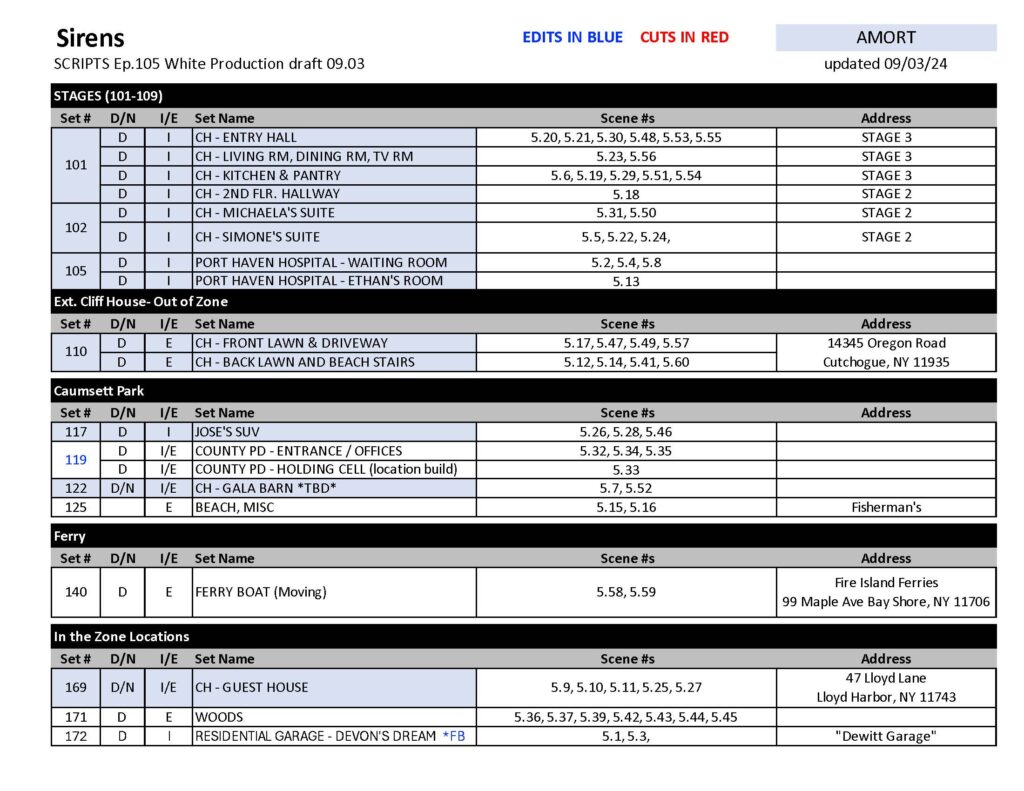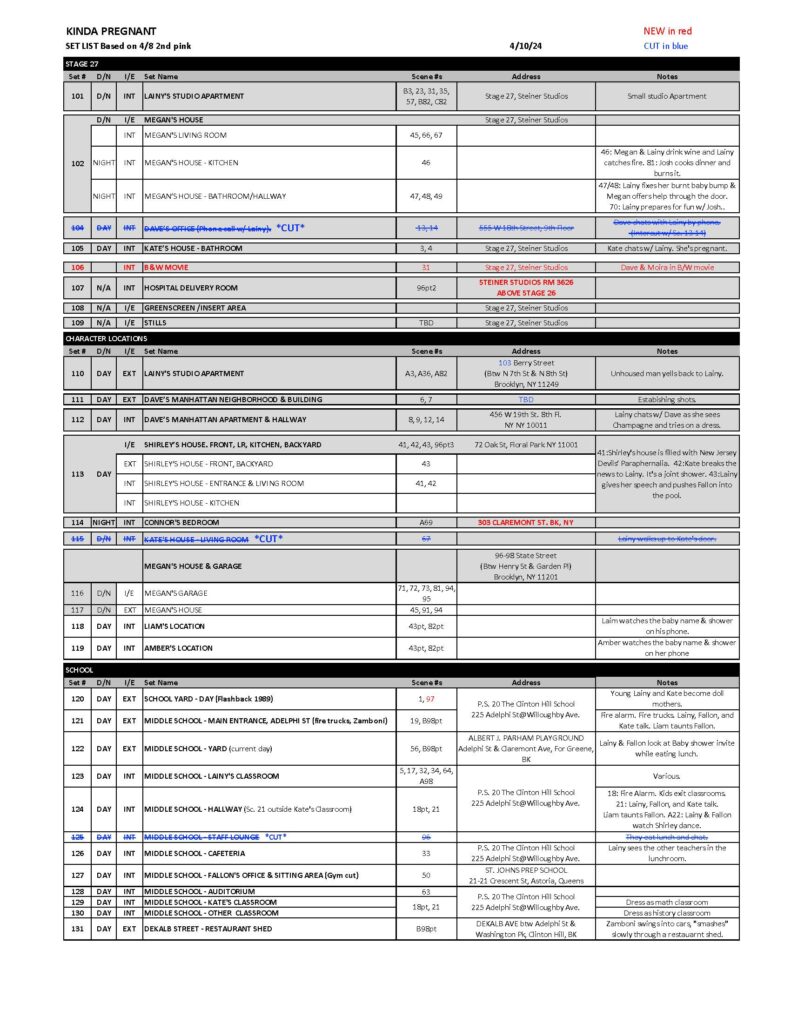
Detail of Kinda Pregnant Setlist. See below for the full example.
Creating a set list is more art than a technical listing of the sets in the script. This may sound obvious, but after 25+ years in the Art Department, I can’t stress enough how important it is to have a set list that works for not only your Set Designers but also for Accounting, Construction, Scenic, Set Decoration and Dressing, Props, and the Locations departments.
There are some challenges you need to work through. Remember, as the show’s Art Director, everyone is looking to you to make sense of all the inconsistencies and contradictions in the script. It’s your job to take the raw information and digest it for the entire crew into a clear structure. They are looking to the Art Director to be the adult in the room and provide clarity. And most importantly, they can’t create an accurate budget until they have your list.
This means reading and rereading the script to understand how the sets fit together. Discussing with the Production Designer which sets are built and which are locations. Before being hired for the job, they may have had a discussion with the producers and committed to specific parameters. Find out before you get everyone in trouble. I’ve had Line Producers yell at me for listing a scene as a built set when the designer committed to making the scene a location as a condition of getting the job. Don’t be me.
Sounds like you better be careful and make sure your set list is 100% correct before releasing it, right?
Wrong. A set list is a living document that requires multiple rounds of discussion before you can arrive at a final version. And once all the locations are chosen, it will change again. Get to a consensus on the first pass and release it as soon as possible. Other departments are depending on it to begin to do their work.
I’ve made some great tools in Cinergy to help make set list creation fast and easy. (Average 15-20 minutes.) But it doesn’t matter if you use Cinergy or Excel. The same principles apply.
Combine:
Screenplay writers can be contradictory. However, remember that there isn’t just one writer. There is a room full of writers, and one writer may call a set something different than the other. I just finished a big show where the same yacht was called five different set names in the same script.
- Set Names: Sets with like names should be combined. So if you have INT JOE’S RESTAURANT – COUNTER AREA and INT JOE’S – BAR COUNTER, they are likely the same set, and it’s just the vagaries of writers.
- If a location has both exterior and interior scenes, start by separating them into different set numbers. Once a location has been chosen and you know how it will be filmed, you can decide either to combine them or keep them separate. However, you may want to keep them separate, even if it’s the same address, if there’s a lot of work to be done at the location. (Work notes) If they are in different locations (different addresses), do not combine them. Your set dressing and crew will constantly be going to the wrong place.
- Interior and Exterior sets: If a set is one or the other, then indicate it as INT. or EXT. before the set name. If they are combined, it should be noted as I/E. Not E/I or EXT/INT.
- Scene length: If you have a one-line schedule or use a program to calculate each scene’s length, then add these together when combining sets. You must add the scenes together on your list. Maintain the 1/8ths. It’s standard industry jargon.
- List all of the scene numbers this set plays.
- Day and Night: If a set is one or the other, then indicate it. If they are combined, it should be noted as D/N. Not N/D or DAY/NIGHT.
- Once a location has been chosen add the address. The crew needs a central place to find information. Please don’t make them search in multiple places.
- Does this set line need a note? Some designers prefer to include a brief description of the action in the scene. It’s a lot of work. But worth it to help people distinguish between sets. The sad truth is that not everyone reads the script.
At some point, Designers and Producers will ask your opinion on which scenes or sets should be cut. (I know their job, right?) The easiest way to answer this is by telling them which sets have the lowest number of scenes and page count. Believe it or not, they are not doing this simple math. They are looking to you.
Categorize:
- SETS: Think of the sets as groups of categories. The simplest is Stage and Locations. But if you have multiple stages, create a STAGE 1 and a STAGE 2. Divide the sets to the stages they could potentially be. If you’re unsure, consult with your Production Designer and UPM/Line Producer to hear their perspective.
- LOCATIONS: Some locations may be filmed by another unit or in a different city or state. You may have a stage in NYC and Locations in Washington, D.C., or perhaps your show has two different tax credit areas and you need to group them this way, such as Locations NY and Locations NJ. Or maybe you are just trying to provide some clarity. This group of sets is the White House, and this group of sets is the Kremlin. They are both on the same stage. Remember, you can always change this later! (But set numbers are forever.)
- Can there be anything other than a set or location? Perhaps! There are 2nd units, special effects, visual effects, stunt, etc. When they come up, you may want to separate them into their own category. They will have repeating scene numbers as the sets above. Or perhaps the AD department has “parted” out the scene to its unit elements. Discuss with your accounting team how they want to number them. You never know how their budget is set up and the tricks they had to perform to pay for this additional work.
Set Numbers: (Finally!)
This is a negotiation with the Accounting Department. They may seem all powerful, but every Production Accountant I have worked with is open to making changes to their system for the good of the show. Talk to them. Listen to their needs and work out a system. But know they are working within specific parameters set by the Studio and the software system they are using.
- Do not number your set list until you are ready to release the first version. The working version should just show the categories and set groupings.
- Try to leave yourself some room to grow. If you start with the stages, then allow for an additional five or ten sets to be added. If your main sets are 101-105, then start your locations with 110 or 120. There are so many times when a small set is added on stage. A closet, a bathroom, a doctor’s office. Etc.
- Your accounting department will encourage you to use as few numbers as possible. This is because they need to establish a separate account line for each. Your 57 sets for episode one are a big headache for them. On the other hand, if they strongly suggest that you only have a small group of numbers, think about your notes, budget, and how you want to split them up. You could compromise on the quantity of set numbers. Perhaps add a letter to set a number if you need to divide the areas of a large set (Sub-sets) for your notes, and the budget The letters are for your internal department use only, Accounting will combine the total materials and labor money on their end.
Conclusion:
A set list can take anywhere from 15 minutes, a few hours, to all day to create. It all depends on your tools. The main takeaway I want you to grasp from this post is that there is no perfect document. It will never be finished. You must help people get their jobs done, and they need information. You can always send out a revision; just be sure you are communicating with all the stakeholders beforehand. I’ve added some examples of the set lists I’ve created. If you have any questions, reach out to me on LinkedIn or email me directly at [email protected]. And take a look at Cinergy. The fastest way to break down a script.
EXAMPLES:


